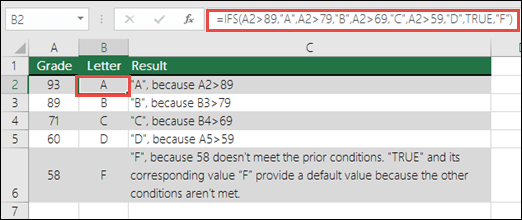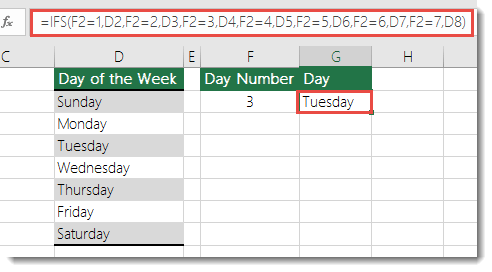IFS function
The IFS function checks whether one or more conditions are met and returns a value that corresponds to the first TRUE condition. IFS can take the place of multiple nested IF statements, and is much easier to read with multiple conditions.
Note: This feature is only available if you have an Office 365 subscription. If you are an Office 365 subscriber, make sure you have the latest version of Office.

Simple syntax
-
IFS([Something is True1, Value if True1, [Something is True2, Value if True2],…[Something is True127, Value if True127])
Notes:
-
The IFS function allows you to test up to 127 different conditions.
-
For example:
-
Which says IF(A1 equals 1, then display 1, IF A1 equals 2, then display 2, or else if A1 equals 3, then display 3).
-
It's generally not advisable to use too many conditions with IF or IFS statements, as multiple conditions need to be entered in the correct order, and can be very difficult to build, test and update.
-
=IFS(A1=1,1,A1=2,2,A1=3,3)
Technical details
Syntax
-
IFS(logical_test1, value_if_true1, [logical_test2, value_if_true2], [logical_test3, value_if_true3],…)
| Argument | Description |
| logical_test1 (required) | Condition that evaluates to TRUE or FALSE. |
| value_if_true1 (required) | Result to be returned if logical_test1 evaluates to TRUE. Can be empty. |
| logical_test2…logical_test127 (optional) | Condition that evaluates to TRUE or FALSE. |
| value_if_true2…value_if_true127 (optional) | Result to be returned if logical_testN evaluates to TRUE. Each value_if_trueN corresponds with a condition logical_testN. Can be empty. |
Example 1

The formula for cells A2:A6 is:
-
=IFS(A2>89,"A",A2>79,"B",A2>69,"C",A2>59,"D",TRUE,"F")
Which says IF(A2 is Greater Than 89, then return a "A", IF A2 is Greater Than 79, then return a "B", and so on and for all other values less than 59, return an "F").
Example 2

The formula in cell G7 is:
-
=IFS(F2=1,D2,F2=2,D3,F2=3,D4,F2=4,D5,F2=5,D6,F2=6,D7,F2=7,D8)
Which says IF(the value in cell F2 equals 1, then return the value in cell D2, IF the value in cell F2 equals 2, then return the value in cell D3, and so on, finally ending with the value in cell D8 if none of the other conditions are met).
Remarks
-
To specify a default result, enter a condition that will always be true for your final logical_test argument, such as TRUE or 1=1. If none of the other conditions are met the corresponding value will be returned. In Example 1, rows 6 and 7 (with the 58 grade) demonstrate this.
-
If a logical_test argument is supplied without a corresponding value_if_true, this function shows a "You've entered too few arguments for this function" error message.
-
If a logical_test argument is evaluated and resolves to a value other than TRUE or FALSE, this function returns a #VALUE! error.
-
If no TRUE conditions are found, this function returns #N/A error.
Need more help?
You can always ask an expert in the Excel Tech Community, get support in the Answers community, or suggest a new feature or improvement on Excel User Voice.
No comments:
Post a Comment